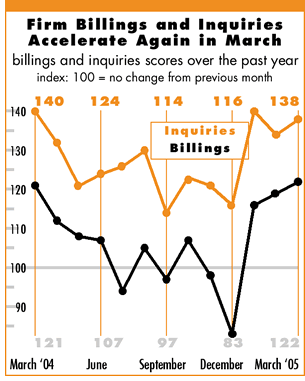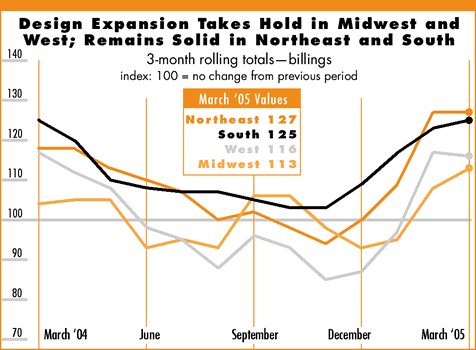

Firms End First Quarter
on an Up Note
Most firms expect to grow over the next
five years

by Kermit Baker,
PhD, Hon. AIA
Chief Economist
 The upturn in business conditions at architecture
firms picked up its pace in March, as almost a third of firms reported
increased billings compared with February levels, while only 10 percent
reported declines. Firms in all regions noted strong business conditions.
While experiencing declines as recently as two months ago, firms in the
Midwest and West are now in the midst of a solid upturn. Firms in the
Northeast and South are building on their strength of recent months.
The upturn in business conditions at architecture
firms picked up its pace in March, as almost a third of firms reported
increased billings compared with February levels, while only 10 percent
reported declines. Firms in all regions noted strong business conditions.
While experiencing declines as recently as two months ago, firms in the
Midwest and West are now in the midst of a solid upturn. Firms in the
Northeast and South are building on their strength of recent months.
Residential firms, as well as firms with a mixed practice (less that 50 percent of billings in either residential, commercial/industrial, or institutional sectors) reported the strongest business conditions in March. Firms of all specializations indicate that inquiries for new projects have been picking up, but residential firms are the most upbeat about prospects for future work.
Industry outpaces economy in general
The broader economy remains in an upturn, but currently is not as strong
as the design and construction portion. Payrolls increased nationally
by a disappointing 110,000 in March, well below the average of the
first two months of the year. Construction payrolls accounted for
almost a quarter of the gain, even though this sector accounts for
only 5-6 percent of payroll positions in our economy.

Consumer confidence also has weakened in recent months. The Conference Board’s reading on consumer confidence has dropped each of the past two months, while the University of Michigan’s consumer sentiment scores dropped each of the past three months.
 Firms predict their own growth
Firms predict their own growth
Business conditions at firms are solid, and most have a positive outlook
for the long term. When asked how their firm in five years from now
will compare to their firm today in terms of size, most see growth
on the horizon. Sixty-one percent of firms think that their firm will
be somewhat larger five years hence, while 11 percent predict that
it will be much larger. Only 3 percent of respondents think that their
firm will be smaller. Most feel that the gains will come from internal
growth, since only about one in eight feels that his or her firm will
acquire or merge with another firm over the next five years.
Anticipated growth will come from both serving a wider range of building types and from expanding the geographic areas served by the firm. Over 40 percent of firms expect to serve more building types in five years. In expanding their scope of design services, 30 percent of firms expect to increase the design disciplines on staff (e.g. engineering, interior design, landscape architecture).
More than 40 percent of firms also plan to expand into new geographic markets, while 15 percent of firms expect to increase the work that they do internationally. Finally, showing a lot of confidence in their future, almost 70 percent of respondents feel that the profitability of their firms will increase over the next five years.
Copyright 2005 The American Institute of Architects.
All rights reserved. Home Page ![]()
![]()
 |
||
| This month, Work-on-the-Boards survey participants are saying: • We continue to have more work than we can
handle. It continues to be difficult to find talented staff. • Missouri is in poor shape and will remain that way for
at least five years. Expect growth in Texas and California. • There is a general buzz in the area about improvements
to the economy, business spending, etc. Conversely, fuel costs,
building material costs, and our lack of rain and snow this winter
are dark clouds. • Very good growth climate. Construction material costs,
however, are creating value-engineering challenges.
|
||